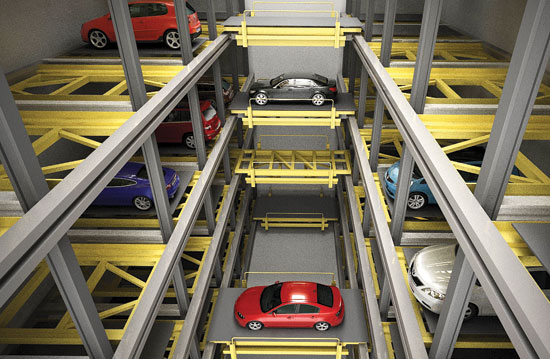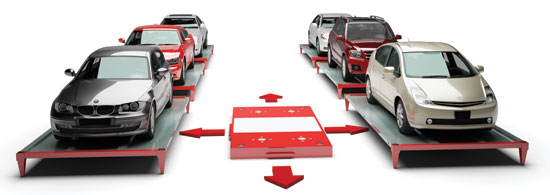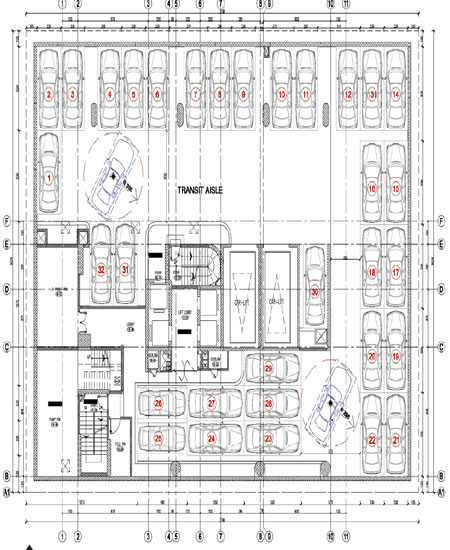Robots Update the Parking Garage
Second-Generation Mono-Path Systems
The second generation of mono-path systems evolved in order to increase processing capacity and limit exposure to mechanical failure by utilizing multiple retrieval shuttles. These shuttles move cars laterally along rails affixed to the front of each side of the storage area on each level of the garage. They then deposit or retrieve the cars into two or more stationary lifts to transport the cars vertically through the structure, where another shuttle will remove the car from the lift and transport it to its storage space.
Disadvantages of second generation mono-path systems:
- The use of rails to guide lateral movement means there is still one lane of lateral movement on any single level, which prevents shuttles from being able to pass by each other and thus limits the processing capacity of the system.
- While redundancy is improved over the first generation, a mechanical failure on the entry/exit level can cripple these systems since 100 percent of the cars must pass through this area on their way in and out of the garage.
- When employed, the floor-to-ceiling central atrium allows fire to spread easily and poses a life safety threat to fire fighters, thus making approvals of these systems very difficult.
- Specialty construction is required to erect the mono-path structure.
- If the structure shifts or the steel rails expand causing misalignment of the rails, the system may be crippled or unusable.
- This is a single-purpose structure that will be difficult to repurpose if this technology is ever obsolesced.
 |
Second-generation “mono-path” shuttle and lift system Image courtesy of Boomerang Systems, Inc. |
Third-Generation Multi-Path Systems
A recently introduced third generation of automated parking systems has come on the market, using AGVs or Automated Guided Vehicles, which are omni-directional battery-powered robots, to store and retrieve cars that are parked atop steel trays. While use of AGVs is revolutionary to the automated parking industry, AGVs have been widely used in car factories and warehouses around the world for the last 30 years.
From the outside, these AGV-based multi-path systems appear to work like other automated parking systems, but when the parking bay door closes a low-profile rectangular AGV rolls under the car and uses its onboard electric motors to raise four posts and thereby lift the tray. The robot then rolls out of the parking bay carrying the tray with the car onboard following its guidance system. Since they are battery operated with four independent wheels, each AGV can move forward, backward and side-to-side, and can spin 360 degrees anywhere in the garage (provided there is room to do so). AGVs can also travel up or down between storage levels in specially designed lifts.
Since the AGVs are not constrained to move along a rail, they are free to move laterally through the garage along multiple paths, which is why they are referred to as “multi-path” automated parking systems. This multi-path functionality enables the AGVs to work around obstacles, thereby avoiding the creation of bottlenecks in the main transit aisle.
 |
Multi-path automated parking system Image courtesy of Boomerang Systems, Inc. |
Benefits of Multi-Path Automated Parking Systems
The vehicles in a true multi-path system are supported above the concrete slab on elevated trays so the AGV can “drive” in any direction throughout the garage underneath parked cars. This ability enables AGV systems to process multiple transactions while avoiding bottlenecks that would have formed in the center transit aisle of first- and second-generation systems.
Additionally, when the ability to move laterally along multiple paths is combined with sophisticated logistics software, suppliers can add many more robots to attain a significantly higher hourly throughput than would otherwise not be possible in a mono-path system.
| Sample Layout of a Multi-Path System |
 |









